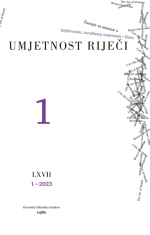Attempts at reconciliation in Aristaenetus' "Erotic letters"
Attempts at reconciliation in Aristaenetus' "Erotic letters"
Author(s): Sabira HajdarevićSubject(s): Sociology, Social history, Greek Literature, Cultural Anthropology / Ethnology, 6th to 12th Centuries, Philology, Sociology of Literature
Published by: Hrvatsko filološko društvo
Keywords: Aristaenetus; reconciliation; reconciliation methods;
Summary/Abstract: Even though scholars are yet to agree on the authorship of the epistolary collection Erotic Letters, it is usually ascribed to Aristaenetus and it was probably written in the 6th century AD. The letters of the collection mostly depict extramarital affairs (with hetairai, slaves or married women), often accompanied by conflicts fuelled by (sometimes justified) jealousy or either partner’s lack of interest because there are better options: e.g. a hetaira gets a richer client, a client is seduced by a younger or better-looking girl, etc. Therefore, most reconciliation efforts in the Letters are in fact the lovers’ attempts to either get back together and improve their relationships or to end them in a civilised manner or otherwise. The focus of the research is on the analysis of the protagonists’ reconciliation strategies and methods (such as verbal persuasion, lying, causing sympathy, projecting guilt onto somebody else, letter-writing, the use of male or female mediators, etc.) and their effectiveness. The final goals are: to point out the most common reconciliation methods employed, to investigate whether or not the men and women use similar methods, to check which gender is more likely to choose indirect reconciliation methods, such as the use of mediators or writing and sending letters, and to examine which gender is generally more successful at reconciliation (as well as to explain why that is so). Additionally, the author’s depictions of reconciliation and his use of reconciliation as a narrative tool are put into a wider context through a comparison with other epistolary collections of this type, the originality of these depictions is scrutinised and probable models (within and outside of the subgenre) are proposed.
Journal: Umjetnost riječi
- Issue Year: 2023
- Issue No: 1
- Page Range: 1-24
- Page Count: 24
- Language: English

